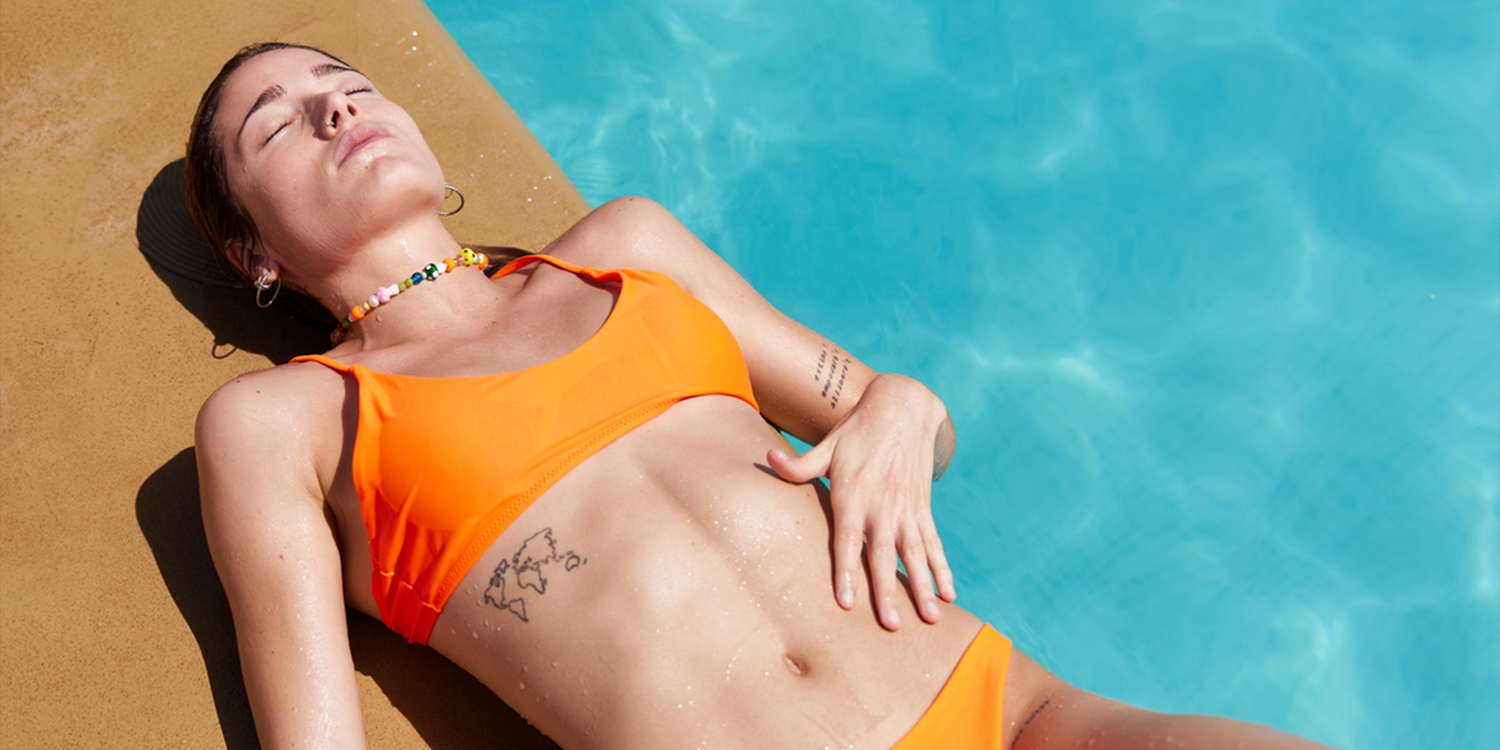Blog
Tanning Is “Trending” Again—But Seriously, Don’t Do It

A sun-kissed tan might look good and make you feel great, but what if we told you that UV exposure is damaging your skin? From lying out beside the pool to hitting the tanning salon, the pursuit of a tanned, bronzed glow is growing increasingly popular these days. But trust us (and dermatologists) when we say: this is a habit that’s truly best to avoid.
Keep reading to gain a deeper understanding of the differences between natural tanning outdoors, tanning beds, and self-tanners, and why the golden glow may not be worth the skin-damaging trade-offs that come with it, as shared by board-certified dermatologists.
Meet the Experts
- Sarah Sung, MD, FAAD, is a board-certified dermatologist and founder of The Perq in Seattle.
- Asmi Berry, DO, FAAD, is a board-certified dermatologist in Los Angeles.
Is There a Safe Way to Tan?
Natural Tans
Natural tanning outdoors is the most well-known method of tanning. The premise is simple: after spending time outside and being exposed to the sun’s UV rays, the skin becomes darker. But not without significant cost.
“These rays cause DNA damage in skin cells almost immediately, even before a tan or sunburn is visible,” says Sarah Sung, MD, FAAD, board-certified dermatologist. “Once the damage is underway, the body responds by activating melanocytes, the pigment-producing cells in your skin.”
These cells produce and distribute melanin, which contributes to the appearance of a tan. The more melanin, the darker the tan. Although it may feel good to soak in the sun’s warm rays, it’s essential to understand that tanning can be very harmful to your skin.
Tanning Beds
When you spend time in a tanning bed, UV light darkens the skin, mimicking the effects of sun exposure. One interesting aspect of tanning beds is that they primarily use UVA rays. They’re designed to minimize UVB rays, which are the primary cause of sunburn. So, you may not experience redness, pain, and other signs of a sunburn after spending time in a tanning bed, but this doesn’t mean a tanning bed tan is safe for your skin. On the contrary, the International Agency for Research on Cancer has stated that tanning beds are carcinogenic to humans.
“The absence of warning signs leads to a false sense of safety, though the cellular damage is even more severe,” Sung says.”
Self Tanner
Dermatologists agree that self-tanner is the only safe way to tan. You have several options here, including mousses, lotions, and sprays containing dihydroxyacetone (DHA). All of these can mimic a tan by staining the top layer of the skin—no sun exposure involved. (We’ve even taken the liberty of testing the best self-tanners for a natural-looking glow.)
“There is no UV radiation involved in self-tanning, meaning no melanin production, no inflammation, no DNA damage, and thus, no increase in skin cancer risk,” Sung says. “It is the only safe way to appear tan. A real tan is your body’s response to injury. A self-tan is just color on the surface, like makeup, but longer-lasting.”
However, there are still a few minor risks to consider. Dermatologists suggest using caution not to inhale spray tan products. As with other skincare products, there’s also a risk of allergic reactions when using self-tanner. Of course, there’s always a chance your self-tanner might leave streaks or orange tones on your skin if it isn’t applied properly, but with proper application, self-tanner can look natural.
What Happens to Your Skin When You Tan?
When you tan, your skin ramps up production of melanin. And that increased production of melanin? That’s your body’s attempt to protect your skin from more damage. “That tan may look like a glow, but it’s actually a visible sign of skin injury,” says Asmi Berry, DO, FAAD, board-certified dermatologist.
Tanning comes with many risks. In the short term, you may experience sunburn, oxidative stress, dehydrated skin, and an inflammatory response that can cause skin damage. Meanwhile, the long-term risks include skin cancer and photoaging, which can lead to wrinkles, hyperpigmentation, sagging skin, and collagen breakdown.
However, there are some differences in the ways that outdoor tanning and tanning beds impact your skin. When you tan outside, your skin is exposed to both UVA and UVB rays. “UVB rays cause sunburn, while UVA rays penetrate deeper into the skin, leading to DNA damage, collagen breakdown, and long-term aging,” Berry says. “Even if you don’t burn, tanning outdoors accelerates the aging process and increases your risk of developing skin cancer, including melanoma.”
Using a tanning bed definitely isn’t doing your skin any favors either. “It is fast, silent, and damaging in a way you can’t feel right away,” Sung says. “You may think it’s safer because you are not burning, but UVA goes deeper and does more lasting harm. You’re skipping the warning signs and heading straight for the long-term consequences.”
What’s Worse—Outdoor Tanning or Tanning Beds?
Compared to outdoor tanning, tanning beds are worse for your skin health (for the record, outdoor tanning definitely isn’t much better). “The concentrated UVA rays cause deeper skin damage and are linked to higher rates of melanoma, especially in younger people,” Berry says. “Just because there’s no sunburn doesn’t mean there’s no harm.”
When you lie in a tanning bed, you’re getting a massive dose of UVA rays that can be stronger than that of the midday summer sun, Sung tells us. This increases the risk of melanoma, especially when tanning beds are used before the age of 35.
“Tanning beds fast-track DNA damage, accelerate visible aging, and dramatically increase skin cancer risk, even more than natural tanning, which already makes dermatologists cringe,” Sung says.
How to Protect Your Skin in the Summer
The best way to protect your skin from sun damage is to limit your time in the sun. But not tanning doesn’t mean you need to hide indoors all summer. Here are some tips:
Wear Sunscreen
First things first, wear sunscreen. In most cases, dermatologists would say this is a non-negotiable. “Wear a broad-spectrum SPF 30 or higher every day and reapply every two hours if you’re outdoors,” Berry says. “If you have sensitive or acne-prone skin, opt for a mineral sunscreen with zinc oxide or titanium dioxide.”
Wear Protective Clothing
If you’re going to be outdoors, wide-brim hats, UV-protective sunglasses, and long clothing can all help keep the sun off your skin. You can even buy ultraviolet protective factor (UPF) clothing that blocks some of the sun’s damaging UV rays. Some people use UV-protecting gloves while driving.
“Hands and forearms get sun daily without you even noticing, and that’s where I see some of the earliest sun damage in patients,” Sung says. “The skin on the hands is some of the thinnest and most delicate on the body.”
Use Self-Tanner
If you’re committed to a sun-kissed glow, there’s one shortcut that doesn’t require sun exposure: self-tanner. According to Dr. Berry, this is the safest way to get a tan without causing skin damage.
The Final Takeaway
The most important thing to keep in mind is that there’s no safe way to tan. A tan can lead to skin cancer, signs of aging, sunburn, dehydrated skin, and other adverse effects. “Any tan is a sign of skin damage,” Berry says. “The safest way to get a sun-kissed glow without the cellular damage is with a self-tanner or bronzing product. Just make sure to apply sunscreen on top.”












